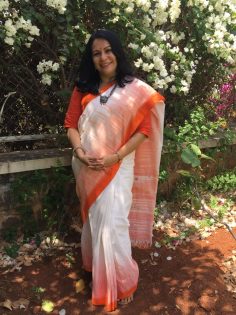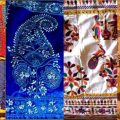Khadi – The Freedom Fabric

15th August is around the corner. Soon, all fashion retailers will their pushing their annual homage to Khadi, trying to cash in on the patriotic sentiment. You will find offers on ‘Khadi cotton’, ‘Khadi silk’ and in some cases, even something called ‘poly-Khadi’, which goes against the very definition of Khadi, even though some govt outfits are also selling it nowadays.
This post is a rant against the indiscriminate use of the term ‘Khadi’ by several unscrupulous retailers.
I have seen even ‘celeb’ sellers and big name designers selling sarees they blithely call ‘Khadi cotton’ or ‘Khadi silk’. They either sell them at very low rates, or the big designers sell what they call Khadi at hugely inflated prices.
The other day I came across someone who claimed she was selling a ‘brand new Khadi pure silk handwoven saree’ for 1800 rupees!
Unfortunately, there are enough women whose eyes light up at the thought of a bargain and they fall hook, line and sinker for such deals. But they need to realise that it is impossible to get even the pure silk yarn at that price, let alone a hand-woven, hand spun saree.
But first let us understand what Khadi really is. Khadi or Khaddar is a hand-woven fabric woven from hand spun natural fibre like cotton, wool or silk. For a fabric to be called pure Khadi, it needs to fulfill all three conditions, the yarn needs to be hand-spun manually either on a single spindle charkha or a multi-spindle solar powered one. The hand-spun yarn needs to be hand-woven on a non-electrical manual loom and the yarn needs to be made from plant or animal fibre, like cotton, wool or silk.
Even if one of these three conditions are not met, the fabric cannot be called pure Khadi. Nowadays, it is difficult to get hand-spun yarn in large quantities, so some weavers compromise by using mill spun yarn for the warp and hand-spun yarn for the weft. Even such fabric may be called Khadi, even though it is semi-Khadi at best.
Khadi is a versatile, eco-friendly fabric that keeps the wearer cool in summer and warm in winter. It’s slightly uneven look is its USP, because everything from spinning the yarn to weaving is done by the human hand. We all know the role Khadi played in India’s struggle for freedom.
In 2017, more than 450,000 people were employed in the various stages of making khadi products. This included cotton pickers, hand-spinners, dyers, weavers and people employed in other ancillary activities.
In 2018, under the Narendra Modi govt the Khadi & Village Industries Commission (KVIC) raised the minimum wage of Khadi yarn spinners to Rs. 7 per hank from the Rs. 4 that was paid earlier. Depending upon the amount of work a spinner does in a day, s/he can hope to get a minimum of Rs. 200 per day. Cotton Weavers who weave simple fabric without any extra weft too get a similar minimum wage.
Now let us take the pricing. A spinner would need at least 3-4 days to hand spin enough yarn to weave a 6.5 mt saree. That’s minimum 600 rupees in wages. Add another 400-600 as weaver wages. And you have 1,000 rupees already just in wages. Add to that yarn cost, dyeing cost, designing cost, transportation cost, procuring cost and the wholesaler and retailer margins, and you will see that why it would be impossible to sell a even a simple Khadi cotton saree for anything less than 2000 rupees, unless it is heavily subsidised by a govt agency like KVIC.
So how are the online sellers selling what they claim are ‘pure cotton Khadi handloom sarees’ at 500 rupees and ‘pure Khadi silk handloom sarees’ at 1800 rupees?
The answer is simple. Neither is the yarn hand-spun, nor is the fabric handwoven. So how do these cotton sarees have this uneven ‘Khadi’ feel, you might ask me, that is because they are woven from the thick slub cotton yarn. Slub cotton is cotton yarn which contains slight lumps and imperfections, often left in the fabric on purpose or remaining in the yarn due to a poor manufacturing process at the mill.

The author Shefali Vaidya in a hand-woven cotton Khadi saree in white and Saffron, with sparsely done Suf embroidery.
Cotton is not the only material in which slubs can be there. Natural linen also can have slubs due to the natural unevenness of the flax fibers from which it is made. Hence you see so many ‘Khadi linen’ sarees.
Now you will ask me, where should you buy authentic Khadi fabrics? KVIC official Khadi Bhandars are the best place to buy genuine hand-spun, hand-woven Khadi, particularly after 2nd October when they have rebates going on for a month. Some govt and private weavers cooperatives also sell genuine handspun Khadi like Dastkar Andhra and Biswa Bangla. But they come at a price.
Then there are some high end designers who sell high count, beautifully woven Khadi, which is often so fine, it reminds you of old time descriptions of muslin. But this kind of Khadi will be prohibitively expensive because you need exceptionally skilled hand spinners to produce such high count, thin, smooth yarn. Each hank of such high count Khadi takes a long time to spin and drives the prices up. But if you can afford such high quality Khadi, do invest in it, as it will last for generations and the price will only increase as supply will fall.
Featured image courtesy: thenewleam.com.
Shefali Vaidya
Latest posts by Shefali Vaidya (see all)
- Life Lessons: How One Man Lost Everything and Reclaimed - July 27, 2024
- Handwoven Textiles: The Original Make In India Product - July 27, 2024
- Khadi – The Freedom Fabric - July 27, 2024






